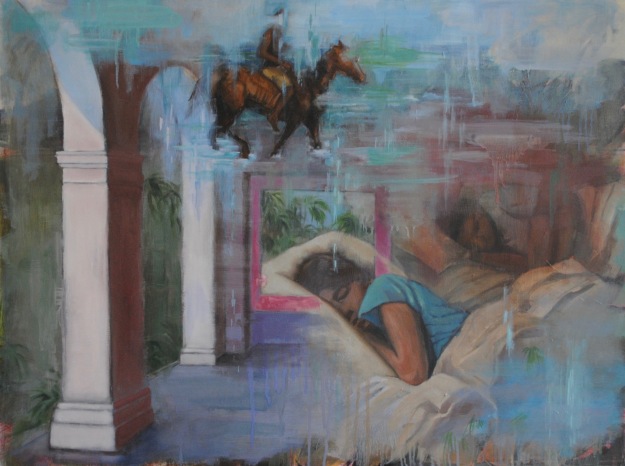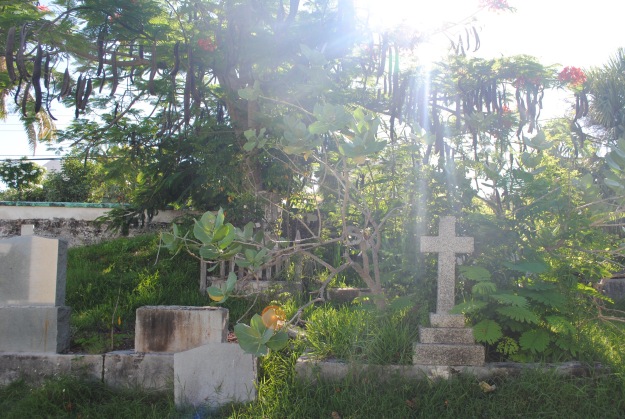


Island Dreams, 2016, oil on wood panel, 24×32″
I think often of an island that fills my childhood memories. My mind goes straight to certain places there: a sweaty dance floor at Sea Grapes before it was rebuilt and then after, the overturned beached dingy with a litter of puppies underneath, a horse named Francis in the living room of a house, Sunday breakfast at Pink Sands before Hurricane Andrew hit, the old Greek magnet’s burned down yet palatial ruins. I remember certain people and realize they are frozen in my memory untouched by time. Larry Cleary singing Night Shift, Dawson kindly walking me home, Gus behind the bar and at the pool table, Carol and Roger in their library, Angela barking orders. Sometimes we presume the people and places in our memories to be accurate accounts in the present. But time does not reach and alter places or people in our memories. They are frozen there until our minds can no longer play that slide show.
Mistakingly, I thought I was a part of this place. But it was and is a place of its own – I was just a shadow passing through. Now, after many years, I look back and ask, how can a place be so important to me, yet I am not important to that place? This is a question to ask ourselves as visitors when we do not contribute to a community with long term commitment, when we are not there through the good and bad, through the reality of living. When we visit a place, we are experiencing an alternate realm, that of a tourist. There is a closed door to the real life there. Considering the local people, their history, lives, families, work, personal struggles and celebrations, we realize how inconsequential we are as visitors. Fondness does not equal belonging.

“Looking Back,” 2016, image transfer, collage and acrylic on paper, 14 1/4 x 21
Despite my fleeting time there, I started a group of paintings about a year and a half ago after visiting Harbour Island for the first time in over 20 years. Returning to a place after many years can be jarring because the present can show us the flaws in our memories, how we romanticize or selectively choose to store certain details and discard others. How we recreate the truth, rewriting our past to fit a script we want to believe. Even when our memories are relatively clear, the passage of time changes a place so we realize what we remember does not really exist anymore, except in our minds.

Entry Point, 2016, oil on wood panel, 21×24 1/4″
In some ways, I started working on this group of paintings when I was 8 years old…I remember being obsessed as a child with the disheveled graveyards sprinkled around the island, with their cracked headstones, and overgrown wildness. Some of my first drawings and paintings were of those headstones, entangled in vines and home to flocks of chickens.
Using memories, photos and sketches from the island has become a vehicle to articulate ideas I’ve tried to convey for years through painting: that everything we see is a partial image altered by individual perception, that all things fade as time passes, and that our memories are altered by our minds plus the passage of time. This group of work is also influenced by the writings of Dr. Alan Lightman. Lightman is unique in that he has dual tenureship at MIT, in the Writing and in the Physics departments. Perhaps he is able to so eloquently write about memory and time because he understands it, not like most of us, in a vague and abstract way, but from a scientific perspective.

Childhood Escape, 2016, oil on canvas, 36×24″
In the NYT article, “Ghost House of My Childhood,” Lightman writes, “Some philosophers claim that we know nothing of the external world outside our minds – nothing compared to what sways in our minds, in the long, twisting corridors of memory, the vast mental rooms with half-open doors, the ghosts chattering beneath the chandeliers of imagination.”
Some of the pieces in this exhibit are snapshots, like a frozen moment captured that can never be seen again in just that way. Some of the paintings reference nature overtaking a manmade structure, which alludes to the passage of time. And some of the paintings combine images like our memories smooshing together poignant moments into one illogical snapshot that we accept as a true moment in the past. For example:
- Disappearing Act, 2016, oil on canvas, 18×24″
- Reminders, 2016, oil on prepared paper, 22×30″
- SOLD
Thank you for reading and I hope you enjoy the paintings and the ideas that inspired this group of work. Laura 
















